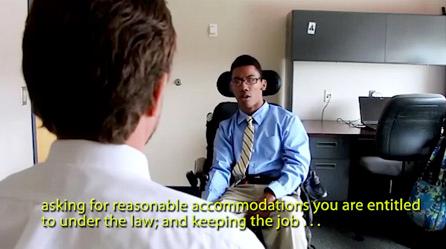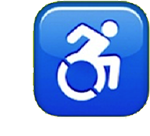RAISE E-News, Vol. 3, No. 1
JANUARY 2017
|

Welcome to the RAISE e-news letter, designed to identify and share resources that the Rehabilitation Services Administration Parent Training and Information Centers (RSA-PTI) can use and share with families.
Executive Editor: Peg Kinsell
Visit our Website:
|
About RAISE
RAISE, the National Resources for Access, Independence, Self-Advocacy and Employment is a user-centered technical assistance center that understands the needs and assets of the RSA-PTIs, coordinates efforts with the TA provided by PTI centers and involves RSA-PTIs as key advisors and partners in all product and service development and delivery.
RAISE is funded by the US Department of Education to provide technical assistance to, and coordination of, the 7 PTI centers (RSA-PTIs). It represents collaboration between the nation's two Parent Technical Assistance Centers (PTAC) and the seven Regional PTACs.
Find your Parent Technical Assistance Center (PTAC)
|
|
 |
|
"We need to make every single thing accessible to every single person with a disability."
- Stevie Wonder, Musician
|
PERSPECTIVE:
Meet Ryan Cenk
 Ryan is a young adult with a disability living outside of Pittsburgh, PA. Ryan's work motto: "I want a job; I am willing to do anything."
Ryan is a young adult with a disability living outside of Pittsburgh, PA. Ryan's work motto: "I want a job; I am willing to do anything."
His advice to other teens looking for work: "Start looking early and work hard. If you don't get the first job, don't get discouraged. Keep trying-be OK with it. Follow your dreams."
|
 RESOURCES: RESOURCES:
The Job Accommodation Network (JAN)
JAN is the leading source of free, expert, and confidential guidance on workplace accommodations and disability employment issues. Working toward practical solutions that benefit both employer and employee, JAN helps people with disabilities enhance their employability, and shows employers how to capitalize on the value and talent that people with disabilities add to the workplace.
JAN's consultants offer one-on-one guidance on workplace accommodations, the Americans with Disabilities Act (ADA) and related legislation, and self-employment and entrepreneurship options for people with disabilities. Help is available both over the phone and online. Just about anyone can benefit from JAN's services, including private employers of all sizes, government agencies, employee representatives, and service providers, as well as people with disabilities and their families.
We love the ASKJAN.org YouTube channel, recently updated.
|
 MAKING YOUR POINT: MAKING YOUR POINT:
Communication During the Interview

In this fun, honest, and open-captioned
video by and for youth with (and without...) disabilities, viewers learn the right and wrong ways to apply for a job, give an interview, request reasonable accommodations, and KEEP a job!
Here are some interview communication tips that transition planners should share-and rehearse-with students:
- Don't keep the interviewer waiting.
- Don't chew gum.
- Greet with a handshake-no fist bumps.
- Act interested. Keep your cell phone off.
- Learn about the job and the company ahead of time.
- Be clean and well dressed, and avoid too much perfume or cologne.
- Bring a portfolio of your accomplishments, honors, and achievements.
- Be ready with some answers to open-ended questions:
- Tell me a little about yourself.
- Why are you interested in working for the company?
- Why do you want this job? ("Make a lot of money" is NOT the right answer.)
- What are your greatest strengths?
- What do you think might be your weaknesses? (Hint: turn it into an asset.)
- How did school prepare you for this position?
- Tell me about a conflict you had at work, and how you solved it.
|

TOOLS THAT WORK:
Overcoming Online Application Barriers
Often, the first barrier to employment is the application itself. In fact, 46% of applicants with disabilities reported that their last experience applying online for a job was "difficult to impossible." So if almost half the folks who want a job can't even apply, the door is shut.
Some of the common accessibility issues with online applications include:
- Complex web navigation that is not intuitive.
- Timeout restrictions that cause an application to close before the user can save or complete it.
- Lack of video captioning.
- Lack of alternative text, which can make images hard to recognize.
- Poor screen/color contrast.
- Inaccessible form fields and mouse-only input options.
Read what Vanita Gupta, Head of the Civil Rights Division at the U.S. Department of Justice, has say to about all this:
"Today, many job applications are completed online. Another barrier to employment faced by some people with disabilities, such as those who are blind or have low vision, are deaf or hard of hearing, or have physical disabilities affecting manual dexterity (such as limited ability to use a mouse), is that online job applications are not fully accessible to them. Individuals with these disabilities use assistive technology, such as screen reading software and captions, to access online information. But websites need to be designed to work with these technologies. Without the ability to access a job application, people with disabilities will not even have the opportunity to apply for a job in the first place. Several investigations conducted by the department found that the public entity's online employment opportunities website or job applications were not fully accessible to people with disabilities. To resolve these violations, the entities must ensure that their online employment opportunities website and job applications comply with the Web Content Accessibility Guidelines 2.0, which are industry guidelines for making web content accessible.
Ensuring that job applications are free from unlawful questions and accessible to all applicants is essential to enable people with disabilities to find work and advance in their jobs. With equal access to employment, hardworking Americans with disabilities can contribute as valued members of the workforce, and both justice and economic advancement are served.
For more information on the department's ADA Title I employment discrimination settlement agreements and consent decrees, visit
www.ada.gov.
Here are some tools that transition planners can use to help employers:
Partnerships on Employment and Accessible Technology offers some great ideas for employers to increase accessibility on the job. Transition planners can share these with employers, and be on the lookout for these common issues when helping students and youth complete online applications.
TalentWorks offers an the online resource that helps employers and human resources (HR) professionals make their eRecruiting technologies accessible to all job seekers-including those with disabilities.
|
 A CLOSER LOOK: A CLOSER LOOK:
#IWantToWorkPA
New for 2017, we will begin to profile local efforts that are advancing the employment of youth with disabilities. This month, we look at #IWantToWork, an innovative social media self-advocacy campaign powered by young Pennsylvanians with disabilities. The goal of the campaign is to make Pennsylvania an "Employment First" state through legislation to ensure people with disabilities have access to fully integrated employment.
The effort is working: In December, Pennsylvania Senator Bob Mench announced he would be introducing the legislation in the State Senate this year, and in early January, Representatives Bryan Cutler and Dan Miller announced plans to introduce legislation in the State's General Assembly. The legislation will not require additional budgeted state spending, but will instead require Commonwealth agencies to shift priorities within existing budgets. When enacted, it will help people with disabilities end their lifetime dependence on governmental assistance by focusing state agencies' efforts on helping them obtain employment and become taxpayers.
Check out their website: http://www.iwanttoworkpa.org/
Follow on Twitter: https://twitter.com/IWantToWorkPA
Follow on Facebook: https://www.facebook.com/IWantToWorkPA

And since we are talking about
SOCIAL MEDIA...
We love this new accessibility icon emoji. While one symbol cannot represent all the physical and mental characteristics of any group, the new Accessible Icon represents more of an idea: that people with disabilities can be active and engaged in their communities. By illuminating movement and motion, the icon celebrates where individuals with disabilities have come from and where they are going next. It is part of the Apple iOS 10 update.
|
 Upcoming Webinars and Training Upcoming Webinars and Training
Technology Considerations and Assessment for Secondary Students, hosted by the Center on Technology and Disability
February 16, 2017, 4:00 PM EST
How do educators work to determine which tools and strategies a student might require in order to ensure a free appropriate public education (FAPE)? When it comes to the selection of technology, there are often numerous options that might be put into place.
|
|